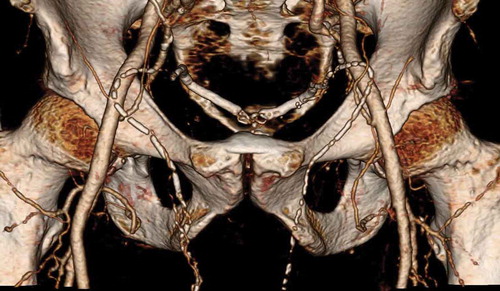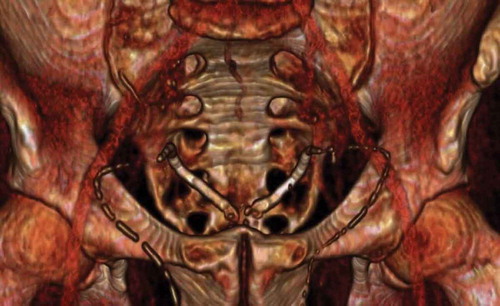ABSTRACT
Vas deferens calcification is a chronic arterio-sclerotic process that develops over many years and is strongly associated with infertility. Incidental findings on imaging are the most common means of diagnosing this condition. We report a case of a 56-year man who likely has male factor infertility and was found to have bilateral vas deferens calcification on CT imaging. This was performed during pre-procedural workup for transcatheter aortic valve replacement (TAVR) for management of severe aortic stenosis (AS). The patient was also had severe calcific multi-vessel coronary artery disease requiring percutaneous coronary intervention with atherectomy. This case highlights a novel clinical association linking infertility with coronary and valvular heart disease. It is possible that this association exists in larger numbers than previously recognized. Closer monitoring of pelvic imaging for TAVR access planning in patients with severe AS may bring more cases to light.
1. Introduction
Coronary and aortic valve calcification is a well-known phenomenon that leads to coronary artery disease and aortic stenosis. While calcification of the vas deferens is rare and has been associated with infertility and diabetes, there is no report in the literature of the association between infertility, calcific coronary artery disease and severe aortic stenosis. We report an interesting case that seeks to establish a novel clinical association linking infertility with coronary and valvular heart disease.
2. Case presentation
A 56-year-old male with a past medical history of hypertension and hyperlipidemia presented for evaluation of progressive aortic stenosis (AS). His family history is significant for coronary artery disease and hypertension. He is a former smoker with a 25 pack-year smoking history but quit 3 years ago. He is married and sexually active with his wife for 20 years, but the couple has not been able to conceive any children. The preliminary workup for infertility approximately 18 years ago was reportedly unremarkable. The patient had been under surveillance for asymptomatic moderate aortic stenosis and recently underwent a routine echocardiogram which showed a normal ejection fraction (EF) of 60% with progression to severe aortic stenosis, aortic valve area (AVA) of 0.9 cm2, mean gradient of 41 mmHg and aortic valve dimensionless index (DI) of 0.23.
A month later, the patient presented to the hospital with fatigue and lightheadedness. He was diagnosed with a non-ST segment elevation myocardial elevation (NSTEMI) and underwent cardiac catheterization which showed severe calcific coronary artery disease (CAD) in the right posterior descending artery, ostial left circumflex, proximal-mid left anterior descending artery with left main involvement (). He was subsequently evaluated by the multidisciplinary heart team for either coronary artery bypass surgery and surgical aortic valve replacement, or transcatheter aortic valve replacement (TAVR) with percutaneous coronary intervention (PCI). Due to patient-preference, a decision was made to undergo PCI with atherectomy and TAVR. STS score was 2.5% with estimated morbidity/mortality of 15.6%. As part of his pre-procedure access planning, a CT scan of the abdomen and pelvis was performed to evaluate the femoral arteries and aorta for procedural access planning. An incidental finding of severe bilateral calcification of the vas deferens was noted (). The patient ultimately underwent successful multivessel PCI with orbital atherectomy, followed by implantation of a # 26 Edwards-Sapien bioprosthetic valve with a reduction in mean gradient to 2.7 mm Hg and no para-valvular regurgitation.
Figure 1. Coronary angiogram showing (a) LAO view of right coronary artery revealing ostial right posterior descending artery stenosis (b) LAO cranial view of left coronary artery demonstrating distal left main disease (c) RAO caudal view showing ostial left circumflex disease and (d) RAO cranial view showing diffusely calcified proximal-mid left anterior descending artery disease

3. Discussion
Bilateral calcification of the vas deferens is a rare condition and has a strong link with infertility [Citation1]. It is a chronic process, developing over a period of years [Citation2]. Diabetes mellitus has been implicated as a common etiological factor. It has also been reported in association with advanced age, mechanical obstruction of the vas deferens, urogenital tuberculosis, chronic gonorrheal or chlamydial infection, schistosomiasis and hyperparathyroidism [Citation3]. Incidental findings on imaging, however, remain the most common means of diagnosing this condition [Citation4].
Patho-physiologically, vas deferens calcification may reflect an underlying global arterio-sclerotic process involving lipid accumulation, inflammation, and calcification leading to degenerative changes [Citation1]. These changes are frequently seen in the coronary vasculature and heart valves as well, particularly in senile calcific aortic stenosis. While cardiac involvement is likely to be frequently encountered in these patients, no such reports or associations exist till date in the medical literature.
In this case, we describe an incidental finding of bilateral vas deferens calcification in a patient with severe calcific coronary disease requiring atherectomy for plaque modification, as well as progressive severe calcific aortic stenosis requiring TAVR. The fact that our patient has not been able to conceive any children despite being sexually active with his wife is suggestive of infertility, for which the couple had reportedly sought medical attention more than a decade ago. Workup at that time included a thorough assessment for female infertility with hormonal testing and imaging (hysterosalpingogram), as well as semen analysis for male factor infertility. Reportedly, testing results had been unremarkable, but the couple decided not to proceed with further intervention, such as in vitro fertilization at that time. On review of prior records, a CT scan of the abdomen performed 14 years prior for evaluation of abdominal pain, showed similar findings of bilateral vas calcification (). Thus, it is very likely that our patient has male factor infertility secondary to chronic bilateral vas deferens calcification, which had remained undiagnosed over the years.
4. Conclusion
To the best of our knowledge, this is the first reported case of the association between infertility secondary to vas deferens calcification with coronary artery disease and severe aortic stenosis. It is possible that this association exists in larger numbers than previously recognized. Closer monitoring of pelvic imaging for TAVR access planning in patients with severe AS may bring more cases to light. It is therefore important for clinicians to recognize this link between infertility and cardiac disease.
Informed consent
Consent was obtained from the patient for manuscript publication and accompanying images
Disclosure statement
All authors declare that they do not have any relevant conflicts of interest.
References
- Wilson JL, Marks JH. Calcification of the vas deferens. Its relation to diabetes mellitus and arteriosclerosis. N Engl J Med. 1951;245(9):321–325.
- Culver GJ, Tannenhaus J. Calcification of the vas deferens in diabetes. JAMA. 1960;173(6):648–651.
- Banerji JS, Devasia A. Calcified vasa deferentia. N Engl J Med. 2011;364(21):2043.
- Stasinou T, Bourdoumis A, Owegie P, et al. Calcification of the vas deferens and seminal vesicles: a review. Can J Urol. 2015;22(1):7594–7598.


